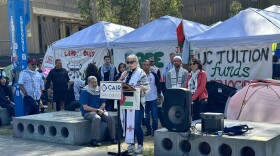This is KPBS Mid-day Edition. Maureen and all. Long-lost letters from a family member can be exciting and bittersweet or the discovery can create a mystery. San Diego writer Julia Dixon Evans has crafted a novel around that idea. The discovery of love letters to a woman -- woman's grandmother that is not from her grandfather. She spoke with producer Michael Lipkin. >> Can you start by reading an opening section of the book is to Mark >> It is the third morning of a wildfire to the east. I have been awake for hours in my brain seems to crawl into my skull. Every wildfire season, I wonder if I am far enough from it. At this concrete grid will repel fire the same way it repels me. Maybe fire will feel right at home here, the same way I do. I care, and I don't. And this is my California. >> Why did you set the book at the height of wildfire season? >> I think it's the most dreadfully -- we suffer in the extended heat and we do not have that change and we have nothing to look forward to. It is very stifling in that way. It is that time I feel most aware of living in San Diego, living in Southern California. So I wanted to set the book there, not necessarily face and it around wildfires but this is sort of a backdrop. >> Describe the main character. >> Sheila is 35 and she has a troubled relationship with her mother. She struggles to hold down a job. She barely sleeps. She is quite obsessive. >>> Streaming of PBS is sponsored by QUALCOMM. QUALCOMM invented the stuff that smart phones rely on. >>> I was getting copies of it and reviewers were getting copies. The first time I saw a picture of the cover out in the wild was when we were driving up the hill to the remains of the house. I think even without that weird coincidence, it would have been indelibly linked because just the title of the book and the prominence of wildfire, I think I have struggled with that. One of the things that I saw when we were up there was my mother in law's cookbooks. It was the first thing I could see. I could still make out some of the words on the page in the bright light. But when I would pick it up it would crumble. So it was depressing. >> What is your connection to the letters? >> What I loved about the story is how she only has half. So letters as an archive are generally one-sided. The way we operate now, our Gmail inbox shows an entire conversation. We can see what we write and what somebody wrote to us. But Sheila only has one half of this conversation. We don't know the other half and that is what drives the mystery for her. Tried to put this mystery together. >> Are there other letters that you have kept in a similar way? >> Yes I had some letters a long distance boyfriend sent me as a teenager. It takes me back. But I also have no idea what I wrote back to him. I am guessing I wrote back because there are signals of a conversation in his letters but I only have one side of it. >>> That was how to set yourself on fire author Julia Dixon Evans speaking to producer Michael Lipkin. She will leave from the desk and read from the book tonight at starlight in Mission Hills. >>> Join us again tomorrow for KPBS Mid-day Edition at noon. If you ever miss a show, you can check out the midday addition podcast. I am Maureen Cavanaugh. Thank you for listening.
Wildfire season feels stifling for San Diego writer Julia Dixon Evans. But it’s also when she feels most aware of her surroundings. She said that mix of misery and charm made it the perfect backdrop for her debut novel, “How to Set Yourself on Fire.”
“Every wildfire season, when a thick blanket of ash hovers between the fire and the ocean, I wonder if I’m far enough from it, if this concrete grid of hundred-year-old suburb will repel fire the same way it repels me,” Evans’ wrote from the perspective of her main character Sheila. “Maybe fire will feel right at home here, the same way I do. Every wildfire, I feel safe and I don’t feel safe. I care and I don’t and this is my California.”
Sheila, a thirty-something, semi-employed temp worker, spends much of the book on a hunt for her family’s past. Her grandmother has recently died, leaving behind a trove of love letters from someone who is not Sheila’s grandfather. But Shelia only has one half of the conversation.
RELATED: What It Means To Be ‘All Grown Up’
Evans, the program director for the San Diego non-profit storytelling group So Say We All, was partially inspired by a series of letters she still has from a long-distance boyfriend during her teens.
“I would read these super eloquent letters, and think, ‘I probably rambled on.’ But maybe I matched him,” Evans said. “I don’t have what I wrote back. For all I know, there’s nothing out there.”
Evans joins KPBS Midday Edition on Tuesday to discuss her new novel and her family’s own history with wildfires.






